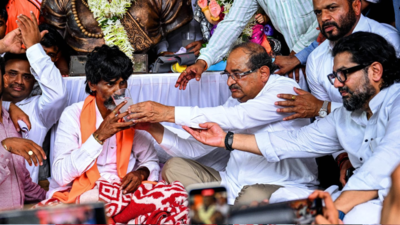ARTICLE AD BOX

MUMBAI: The five-day Maratha quota protest in Mumbai, led by activist Manoj Jarange, drew tens of thousands to Azad Maidan, paralysed south Mumbai’s busiest stretches, and kept the city on edge.
While the state government eventually conceded to most demands and the agitation ended peacefully, several striking details—from massive police deployment to protesters camping at CSMT—went unnoticed. Here are 15 key moments you may have missed.

1. The scale of the protest: Though police granted permission for only 5,000 agitators, more than 60,000 people arrived in nearly 8,000 vehicles, paralysing roads around CST, Azad Maidan, and Mantralaya.

2. Heavy police deployment: Over 1,500 Mumbai police personnel were on ground, backed by CRPF, CISF, RAF, SRPF, Riot Control Police, and the Maharashtra Security Force.

3. Strategic meetings beforehand: Police held multiple rounds of talks with Jarange’s core team before the agitation began, anticipating a spillover crowd.

4. Technology in play: Drones and 24/7 CCTV surveillance across south Mumbai helped police track crowd movement and prevent flashpoints.

5. Hunger strike pressure: Jarange launched his indefinite fast on August 29, intensifying pressure on the state. He finally ended it on Sept 3 when most demands were met.

6. Traffic paralysis: Major choke points—CSMT, Flora Fountain, Marine Drive—saw massive jams. Commuters struggled during morning peak hours.

7. CSMT turned into protest camp: Protesters turned the iconic terminus into a shelter, spreading mats on platforms, cooking, and sleeping inside.

8. Police-activist coordination: At times, protesters blocked roads and refused to budge. DCP Pravin Mundhe made a video call to Jarange, who asked followers to cooperate—defusing tension instantly.

9. High court intervention: On Sept 2, Bombay HC pulled up authorities, saying Mumbai was “literally paralysed.” The court ordered protesters to vacate Azad Maidan by 3 pm on Sept 3.

10. Government’s dilemma: While negotiations were on, the state faced HC’s warning to clear the roads, forcing officials into a balancing act.

11. Protest spillovers: Groups of agitators staged mini demonstrations at Mantralaya, BSE, Gateway of India, Jehangir Art Gallery, Girgaon Chowpatty, and Marine Drive.12. Public announcements: Police made repeated loudspeaker appeals, urging agitators to shift vehicles to Navi Mumbai to ease gridlock.

13. Court orders ignored briefly: Despite HC directions, protesters lingered at Azad Maidan till senior cops personally appealed to them.

14. Appreciation for police: After the site was cleared, Joint CP Satya Narayan Choudhary lauded the force: “You handled this well. I’m proud of you.”

15. Protest legacy: Jarange’s Mumbai stir became one of the largest Maratha protests in the city in recent years—peaceful but disruptive, showcasing both public anger and the city police’s crowd-control skills.



.png)
.png)
.png)
















 20 hours ago
3
20 hours ago
3








 English (US) ·
English (US) ·